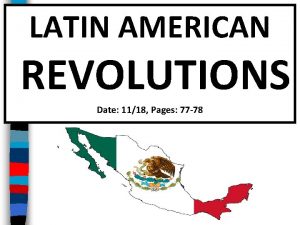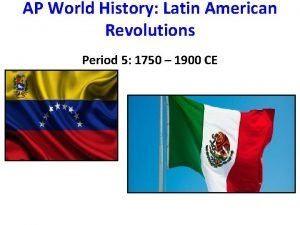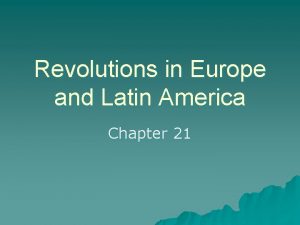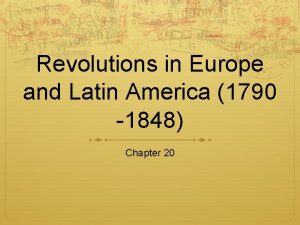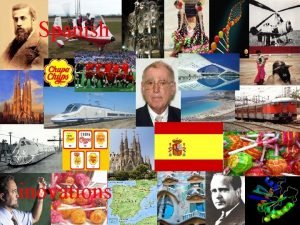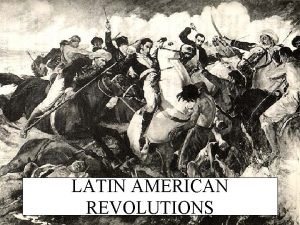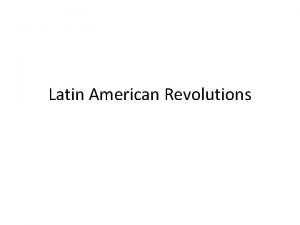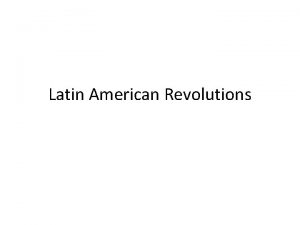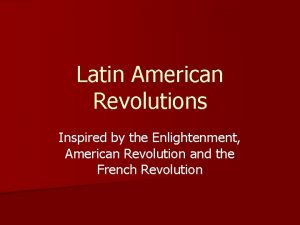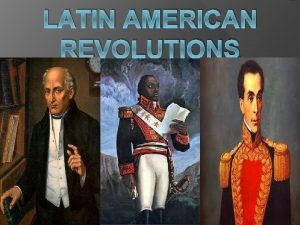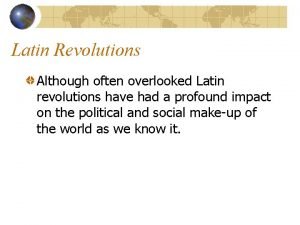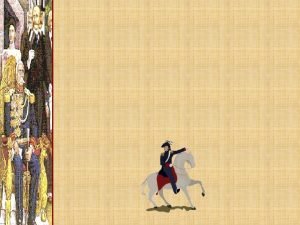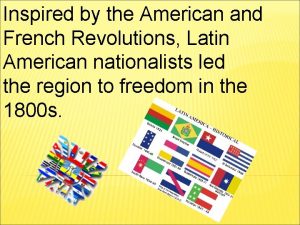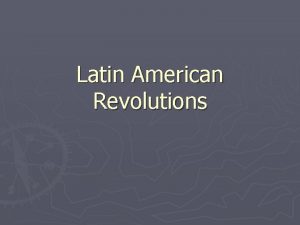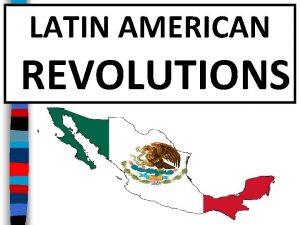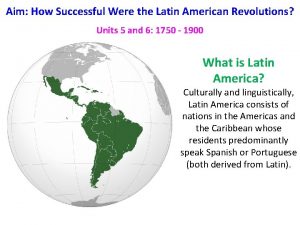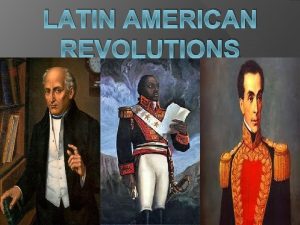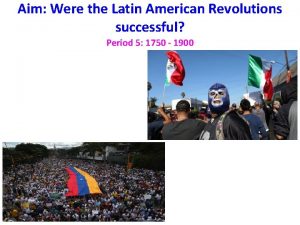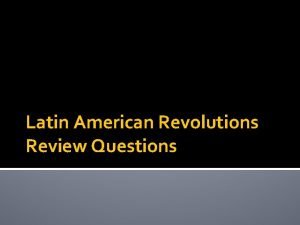Latin American Revolutions Latin American revolutions were inspired


















- Slides: 18

Latin American Revolutions – Latin American revolutions were inspired by prior revolutions including the American colonies revolt against England as well as the French Revolutions and its phases – The Haitian Revolution in particular echoed the French revolution with its escalating violence and terror. – Differences between revolutions in Latin America can also be noted as the areas are so diverse in all respects. If you know Latin America today you will understand why this would be so. Mexico, Chile, Jamaica, Haiti, Cuba are all part of Latin America so you can see why even revolutions could be different

The Haitian revolution – Haiti is part of the island of Hispañola-the island first conquered by Spain in 1493 – By 1790 Haiti (known as Saint Domingue) was a French Caribbean colony regarded as the richest colony in the world due to its production of sugar – 90 -95% of its inhabitants were slaves; 3% were “colored”; 2% were white Europeans. Needless to say, the 2% were considerably better off than the other 98%.

The Haitian Revolution – With the onset of the French Revolution, unrest came to French colonies including Haiti – Remember, revolution means different things to different people – To the white Europeans it meant republican government and liberty – To the “colored” it meant, perhaps, equality with the whites and some economic benefit – To the slaves it meant freedom. – Over time factions developed in Haiti each claiming to be the government. Each faction held the other in contempt, with the whites and “coloreds” refusing to recognize the freedom and liberty of the slaves.

The Haitian Revolution – In 1791 a slave rebellion occurred which was to continue until Haiti achieved its independence from France in 1804 – The great Haitian leader Toussaint L’Ouverture was the fulcrum of the slave rebellion, and although he was later captured by the French and died in prison, he inspired a continuing spirit of resistance. – The rebellion or revolution was successful: the only completely successful slave revolt in recorded history. Think about that-how many times do you think slaves have rebelled against their slavery?

The Haitian Revolution – Saint Domingue was renamed Haiti meaning “mountainous” in the original Native American language of the area – Haitians identified themselves with the original inhabitants of the area though none of them survived past 1535 – Declared equality of all races – Divided all plantations among small owners – Haiti was the 2 nd independent nation in the western hemisphere after the United States

The Haitian Revolution – However, Haiti did not have an easy time. The destructiveness of the revolution, internal divisions, external dangers, led to poverty and instability. For years Haiti suffered under arbitrary strongman rule – Success of Haiti’s revolution generated both hope and fear: – Created new hope for liberty among slaves everywhere in the Americas and fostered many rebellions (none successful) – Created fear and horror among white slave owners in all of the Americas, led to new restrictions and to the identification of slavery as a positive economic and social institution among slave holders.

The Haitian Revolution – The end of slavery in Haiti did little to stop the slave trade or use of slaves. The slaves no longer sent to Haiti ended up in Brazil, the islands of the Caribbean, Spanish America, or, illegally in the United States. – One interesting note: Napoleon attempted to invade and conquer Haiti in 1802. His army was destroyed by yellow fever and the Haitians. As a result, Napoleon gave up his idea of creating a French American empire based on New Orleans and sold the Louisiana Territory to the United States. (Louisiana, Arkansas, Missouri, Oklahoma, Kansas, Nebraska, N. and S. Dakota, Montana, Wyoming, Iowa, parts of Texas, Minnesota, Colorado were created from this territory) Thank you Haiti!!!!!

Revolutions in Spanish America – Many of the attributes of revolution in Spanish America do not apply to Brazil. If you are interested in the unusual way Brazil obtained its independence from Portugal please have a look. – In the 18 th century, the Spanish government extended and deepened its control of its colonies in the Americas. This involved sending out Spaniards to the colonies to rule and investigate. – American born Spaniards (creoles, crillollos) were ignored in government and treated as second class persons. This offended many of this group. This is similar to the British treatment of their “creoles” in the North American colonies.

Spanish America – However, there was very little movement towards revolution and independence among the creoles for a variety of reasons. – They were afraid of social mobility for mestizos and other castas – They did not necessarily believe in the revolutionary doctrines. Spanish authorities had (unsuccessfully) attempted to limit circulation of revolutionary tracts and concepts, and although some people subscribed to them, the majority of people with agency did not.

Other reasons for hesitancy – Little tradition of self government- in many case no tradition of self government – Society was hierarchical, much stricter in this sense than the North American colonies – Whites were outnumber at least 5 to 1 or 10 to 1 in many areas. While in the North American English colonies whites outnumber all others by 5 to 1 – Education was very limited even among white creoles. – The power of the Catholic church was extremely strong especially among the lower classes and castas.

Here comes the Revolution!!!! – Surprisingly, most Latin American colonies were forced into revolution because of events in Europe. – In 1808 Napoleon had overrun Spain, imposed a puppet king, and essentially reduce Spain to chaos. Spain rose in revolt against France as well as against its royal family. – Most creoles in the American colonies were determined to protect their positions. The easiest way to do this was to declare themselves to be independent of Spain at least until things settled down. This is a simplistic statement but carries the essence of what happened.

Revolution!!!! – One thing led to another and by the time Spain had got rid of Napoleon and was ready to take up its empire, the empire had decided it could get along pretty good without Spain. – By 1826 all Latin American colonies on the North and South American continents had obtained independence from Spain. Some islands in the Caribbean did not do so until much later. – The process of winning independence took longer in most areas in Latin America than the American Revolution in North America

Founding Fathers of Latin America: Bolivar, San Martin, Hidalgo dennysdaysissimonbolivar. blogspot. co m en. wikipedia. org www. biografiasyvidas. com

The Liberators – Bolivar- Leader of rebellions against Spanish in Venezuela, Colombia, Ecuador, Bolivia, and Peru. Bolivar is honored throughout South America as “El Liberador” – San Martin- Led liberation in Argentina, Uruguay, and with Bernardo O’Higgins in Chile. San Martin, deferred to Bolivar after freeing Chile, and ended his life in exile in Paris. – Hidalgo- Instrumental in leading the first (though unsuccessful) revolution against Spanish rule in Mexico. Hidalgo was executed, but his passion for the people of Mexico is remembered and honored today.

From revolution to independence – Latin American societies were much more diverse than the English North American colonies: class, race, and regions differed greatly between colonies – Fear of social rebellion by the lower classes and castas shaped the whole independence movement fragmented creole intentions and outcomes – The leaders of the revolutions were generally creoles who were raised on European ideas of the enlightenment. These ideals were for the most part useless in governing these societies at this time

Independence – Leaders also appealed to all classes in terms of nativism: all free people born in the Americas were Americanos. – Problems: many whites and mestizos regarded themselves as Spanish and not Americans. – Lower classes and mixed race peoples, native Americans, and slaves gained little from independence-in many cases they didn’t even gain liberty or freedom – Unlike its northern or European counterparts, revolution in Latin America did not even look at gender issues or conceive of gender issues in the first place

Why isn’t there an EUA – Why isn’t there a United States of America stretching from Mexico to the tip of South America? – While one can never be certain here are some observations that seem to make sense: – Distances between colonies were greater, colonial experiences were different, different regional identities existed. Mexicans recognized themselves, for example, but didn’t identify with Peruvians. The same was true in Gran Colombia, which soon broke up into Venezuela, Colombia, and Ecuador

Why isn’t there an EUA? – Economic relationships were different – Levels of education and church involvement were different from new nation to nation – Overall, too many impediments to union existed. The main one may have been a lack of will to attempt/make any Union successful – In 1800 the USA was a small, economically marginal country while Latin America was large, populated, and extremely well off – By 1900 the USA was a large, stable, wealthy, democratic state. Latin America was more and more underdeveloped, impoverished, undemocratic, and unstable. This was a reversal of 300 years of colonial history.
 Latin american revolution date
Latin american revolution date Latin american revolution definition ap world history
Latin american revolution definition ap world history Revolutions in europe and latin america section 1 quiz
Revolutions in europe and latin america section 1 quiz Revolutions in europe and latin america
Revolutions in europe and latin america Invention imitate nature
Invention imitate nature Hunger games greek mythology
Hunger games greek mythology T piece oxygen delivery
T piece oxygen delivery Nature-inspired learning algorithms
Nature-inspired learning algorithms Moving figures inspired by futurism
Moving figures inspired by futurism The marxist literary criticism is inspired by carl jung
The marxist literary criticism is inspired by carl jung Great teaching inspired learning
Great teaching inspired learning The tempest movie by william shakespeare
The tempest movie by william shakespeare All scripture is inspired by god
All scripture is inspired by god Inspired versus infringing
Inspired versus infringing Conviction inspired by deep thinking
Conviction inspired by deep thinking The inspired
The inspired Greatly inspired
Greatly inspired Katal. architekt 1926
Katal. architekt 1926 Indications of oxygen therapy
Indications of oxygen therapy
